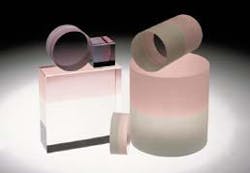Hybrid glass substrate technology leads to hybrid waveguide devices
A proprietary, low-temperature method of joining active and passive phosphate glasses was recently developed by researchers at Schottglass Technologies (Duryea, PA). Hybrid glass substrates prepared with this method contain joints that are chemically and physically robust enough to survive water-based machining and ion-exchange fabrication of waveguides in molten potassium nitrate (KNO3), according to researchers Sam Conzone and Joe Hayden. The process can be used to prepare hybrid preforms that can be diced, polished, and ion-exchanged to form hybrid waveguide devices.
To investigate the low-temperature process, the researchers prepared two sodium aluminophosphate glasses. One glass was codoped with erbium (Er), ytterbium (Yb), and lanthanum (La), which made the phosphate glass "active;" the other was doped with La, making it "passive." A nonlasing component, lanthanum oxide (La2O3), was added to both the active and passive glasses to ensure a consistent rare-earth oxide content on a mole percent basis and to minimize the differences in optical and physical properties. Blocks of active and passive glass with dimensions of 50 x 20 x 17 mm, and 50 x 20 x 33 mm, respectively, were cut from the castings. The joining process was initiated by sandwiching an aqueous phosphate solution between the polished surfaces of the active and passive blocks. The resulting hybrid preform was allowed to cure at room temperature, and a rigid joint was formed within 24 hours.
Hybrid glass substrates were prepared for waveguide fabrication by dicing a heat-treated preform and polishing it to final dimensions of 50 x 50 x 2.0 mm. Waveguides were formed in a hybrid glass substrate by thermal ion exchange in molten KNO3 for 4 h at 375°C. Four sets of waveguides were prepared on a single substrate containing 11 waveguides formed by an aluminum mask consisting of channel apertures varying in width from 3.5 to 8.5 µm. The waveguides were oriented perpendicularly to the joint between the active and passive regions. The specimen was cut and polished to a total length of 2.4 cm, with 1.1 cm of active and 1.3 cm of passive waveguide length. The researchers inspected the surface properties of the glass substrates with an atomic-force microscope to determine the effect of the ion-exchange process on the joint. Atomic-force microscope scans revealed that the surfaces of the active and passive glass and joint interface became slightly etched while they were immersed in the molten KNO3. The active and passive glasses were etched by approximately 0.5 to 0.9 µm, respectively, and the joint interface was etched by approximately 0.2 µm more than the active glass.
The reflectance at the joint interface was measured with 1531.2-nm light optical low coherence reflectometry and found to be -34 ±2 dB.
The researchers then built a Fabry-Perot cavity waveguide laser incorporating the hybrid waveguide. The output power was measured as a function of pump power for the hybrid device by use of a 20% cavity output coupler. To compare the laser performance of the hybrid waveguide with a waveguide with no joint interface, a laser in a monolithic glass substrate was evaluated. This device was fabricated simultaneously with the hybrid device in a glass substrate with Yb, Er, and La contents identical to those in the active section of the hybrid glass substrate. An observed difference in slope efficiencies was typical of normal variations when two devices are prepared with different active waveguide lengths. The fact that the hybrid device yielded a higher slope efficiency suggests that the loss incurred by the joint interface is sufficiently small to permit laser performance that is at least comparable with that obtained in a monolithic device, according to the researchers.
"Hybrid glass parts composed of passive and active sections of phosphate glass are an attractive route to integrate multiple functions onto single substrates and offer the potential to fabricate advanced laser sources, amplifiers, and other photonic devices such as lossless splitters," says Hayden. "Combined with new and novel active materials, this technology will make possible the creation of devices with increasing integration and complexity."
REFERENCE
- S. D. Conzone et al., Optics Lett., 26, 8 (April 15, 2001).
About the Author
Sally Cole Johnson
Editor in Chief
Sally Cole Johnson, Laser Focus World’s editor in chief, is a science and technology journalist who specializes in physics and semiconductors.

